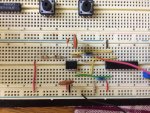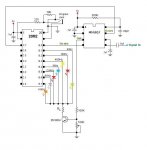Hey all. I'm working with a picaxe 20m2 and a MSGEQ7 equalizer. I appear to have it doing something and by something I mean it's giving me values on the output but the problem is, it's doing it wether or not I have an audio input. I've checked and rechecked my circuit and all seems good (minus a couple of slightly different resistor values). I've also played with the strobe and reset times but it didn't make a bit of difference. If I comment out the strobe then I get practically nothing out but with it active I get something much higher out. Has anyone played with one of these chips that might be able to give me some tips?
Thanks
Output without audio input
Output with audio input

Thanks
Code:
#picaxe 20m2
setfreq m2
symbol ctrlReset = b.0
symbol ctrlStrobe = b.1
symbol channelLeft = c.7
symbol spectrumLeft = b0
symbol position = b1
position = $1c
low ctrlReset
high ctrlStrobe
main:
high ctrlReset
low ctrlReset
pauseus 38
disconnect
sertxd("Updating.... standby", 13, 10)
reconnect
do while position < 35
low ctrlStrobe
pauseus 20
readadc10 channelLeft, spectrumLeft
poke position, spectrumLeft
position = position + 1
high ctrlStrobe
pauseus 20
'pause 500
'spectrumLeft = spectrumLeft + 1
loop
high ctrlReset
position = $1c
do while position < 35
peek position, b2
disconnect
sertxd("The value of b2 at position", " ", #position, " is ", #b2, 13, 10)
reconnect
position = position + 1
'debug
loop
position = $1c
pause 500
goto mainOutput without audio input
Code:
Updating.... standby
The value of b2 at position 28 is 68
The value of b2 at position 29 is 83
The value of b2 at position 30 is 73
The value of b2 at position 31 is 142
The value of b2 at position 32 is 71
The value of b2 at position 33 is 204
The value of b2 at position 34 is 199
Code:
Updating.... standby
The value of b2 at position 28 is 51
The value of b2 at position 29 is 147
The value of b2 at position 30 is 151
The value of b2 at position 31 is 172
The value of b2 at position 32 is 163
The value of b2 at position 33 is 146
The value of b2 at position 34 is 70

